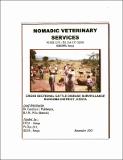| dc.description.abstract | This study was undertaken to identify the major diseases affecting and limiting
the health and productivity of indigenous zebu cattle in 3 divisions of Bungoma
district, Kenya.
The survey established the prevalence rate of these diseases over the 2 months
period (of the exercise) and looked at the effect of age and sex of cattle on
infection by different diseases and conditions.
During the survey, 1040 indigenous zebu cattle from 13 sub-locations had their
samples (faeces, blood, lymph node smears and ticks, Amhyllyoma SPP)
collected and analyzed both in the field and in the laboratory for trypanosomiasis,
worms, babesiosis, anaplasmosis, east coast fever and cowdriosis. Biconical
traps were also used (3-6 per sublocation) to trap tsetse flies which were later
identified.
Faecal samples were subjected to the McMaster egg counting technique and
worm egg counts per gram of faeces determined. Blood was collected from the
ear vein of target animals into heparinized capillary tubes for determination of the
packed cell volume (PCV) which was used as an indicator of the anemia status
for each animal. Examination of the buffy coat and thin as well as thick blood
smears was used to study the presence of trypanosomiasis. Thin blood smears
were also used to detect babesiosis and anaplasmosis, while lymph node
smears were done to examine for East Coast fever. Samples of Ambylyomma
SPP(ticks) were collected to analyze the present of cowdriosis.
Out of the 1040 cattle examined as previously described, 28 (2.7%) were found
to be positive for trypanosomiasis, 64 (6.15%) had east coast fever, 25 (2.4%)
had babesiosis and 30 (2.9%) had anaplasmosis. Tamuleka had the highest
number of trypanosomiasis cases (7), followed by Machakha (5) and Chebukuyi
(4) and West Siboti (4). It was found in this study that 60.7% of all the
trypanosomiasis case were caused by Trypanosome Congolense, and 39.3% by
T. vivax.
A total of 23 tsetse flies were got in this exercise from 54 traps laid out across in
the study area. Tamuleka had the highest number of flies trapped (7), followed
by Machakha (6) and Chebukuyi (4) over the 48 hour trapping period. Most of
the flies got were G. pailidipes. The low fly numbers reported in this study could
be due to high level trapping and baiting that was already going on in the area.
There was uniform infection of all cattle in all areas with worms. About 30 — 50
animals in each sub-location were sampled for worm egg counts. Emphasis was
given to young stock and those in poor condition. In general, this study reports
an average worm egg count of 306.1 eggs per gramme of faeces for all areas
and studied. Male calves had the highest EPG of 522, followed by female
calves (448), female growers (303.8), male growers (257), female adults (252.2)
and male adults (228.5)
It was observed during this survey that there is a very high tick infestation in all
the animals studied. This coupled with the tsetse fly situation calls for a
combined tick and tsetse fly control program. It is also noted that provision of
veterinary services in the area is a major constraint to farmers, which needs to be
addressed. | |
